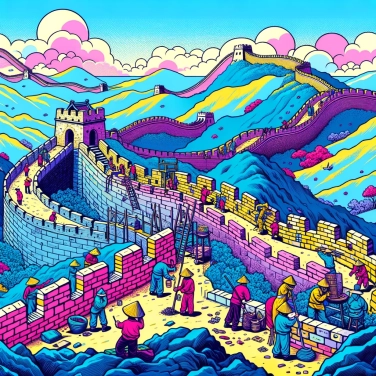In detail, for those interested!
First fortifications and motivations
The first fortifications in China date back to the period of the Warring States (475-221 BC). Originally, these fortifications were not yet connected to form a continuous great wall. The leaders of the time built these fortifications to protect their territories from invasions by nomadic tribes from the north. These early fortifications were mainly made of earth and wood walls.
The unification of China by the Qin dynasty (221-206 BC) marked the beginning of the construction of the Great Wall. Qin Shi Huang, the first emperor of the Qin dynasty, had the different existing fortifications connected and reinforced to form a single defensive structure. The main motivation behind the construction of this Great Wall was to protect against invasions by the Xiongnu, a confederation of nomadic tribes from the north.
In addition to its defensive function, the Great Wall also served as a means of controlling population movements, trade, and communication. It symbolized the power and greatness of the Chinese empire. The construction work of the wall mobilized hundreds of thousands of workers and was often carried out in difficult conditions.
In summary, the first fortifications in China were developed to protect against invasions by nomadic peoples from the north, while the construction of the Great Wall under the Qin dynasty aimed to strengthen this defense and assert the power of the Chinese empire.
Evolution of the construction of the Great Wall
The construction of the Great Wall of China has undergone different phases and evolutions over the centuries. Initially made up of independent fortification sections, it was gradually connected to form a continuous system under the Qin, Han, and Ming dynasties. Under the Qin dynasty, the wall was built with rammed earth and stone to protect the territory from nomadic invasions.
During the Han dynasty, the wall was rebuilt and expanded with improved techniques, including the use of baked bricks instead of earth. It was during this time that the wall took on a form closer to what we know today.
Under the Ming dynasty, the Great Wall was reinforced and rebuilt on a larger scale to face the growing threats of the Mongols and the Manchus. Watchtowers were added along the wall for better surveillance and communication.
Over the centuries, the construction of the Great Wall has been a colossal undertaking, mobilizing immense human and material resources. It is a testament to the ingenuity and determination of the Chinese people to protect their territory from foreign invasions.
Defensive strategies and the usefulness of the wall
The Great Wall of China was a formidable defensive structure built to protect Chinese territories from invasions by nomadic peoples from the northern steppes. It was composed of fortifications such as walls, watchtowers, and guard posts, thus reinforcing the defense of the Middle Kingdom.
The defenses of the Great Wall were strengthened by sophisticated military strategies. Regular patrols were conducted along the wall to spot enemy movements. Alert signals were used to warn garrisons in case of imminent attack. Soldiers were trained to fight in mountains, on rugged terrain, making any invasion attempt extremely difficult.
In addition to its defensive role, the Great Wall also had symbolic and economic utility. It represented the power and grandeur of Chinese civilization, demonstrating the empire's ability to defend itself against external threats. Furthermore, the wall facilitated the control of population movements and trade along the border, which helped to strengthen the authority of the central state.
In summary, the defensive strategies implemented along the Great Wall and its multiple uses as a symbol of power, physical barrier, and regulator of trade have made this iconic structure one of the wonders of the ancient world.
![Explain why some countries change time zones?]()
![Explain why Alexander the Great refused to wear shoes.]()
![Explain why Alexander the Great always wore an impressive helmet.]()
![Explain why the last Chinese emperor was so young when he came to power?]()





















